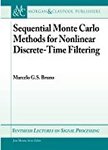版权所有:内蒙古大学图书馆 技术提供:维普资讯• 智图
内蒙古自治区呼和浩特市赛罕区大学西街235号 邮编: 010021

丛 书 名:Synthesis Lectures on Signal Processing
I S B N:(纸本) 9781627051194
出 版 社:Morgan & Claypool Publishers
出 版 年:2013年
主 题 词:Communications Engineering \/ Telecommunications
学科分类:0711[理学-系统科学] 0809[工学-电子科学与技术(可授工学、理学学位)] 07[理学] 08[工学] 080401[工学-精密仪器及机械] 0804[工学-仪器科学与技术] 080402[工学-测试计量技术及仪器]
摘 要:In these notes, we introduce particle filtering as a recursive importance sampling method that approximates the minimum-mean-square-error (MMSE) estimate of a sequence of hidden state vectors in scenarios where the joint probability distribution of the states and the observations is non-Gaussian and, therefore, closed-form analytical expressions for the MMSE estimate are generally unavailable. We begin the notes with a review of Bayesian approaches to static (i.e., time-invariant) parameter estimation. In the sequel, we describe the solution to the problem of sequential state estimation in linear, Gaussian dynamic models, which corresponds to the well-known Kalman (or Kalman-Bucy) filter. Finally, we move to the general nonlinear, non-Gaussian stochastic filtering problem and present particle filtering as a sequential Monte Carlo approach to solve that problem in a statistically optimal way. We review several techniques to improve the performance of particle filters, including importance function optimization, particle resampling, Markov Chain Monte Carlo move steps, auxiliary particle filtering, and regularized particle filtering. We also discuss Rao-Blackwellized particle filtering as a technique that is particularly well-suited for many relevant applications such as fault detection and inertial navigation. Finally, we conclude the notes with a discussion on the emerging topic of distributed particle filtering using multiple processors located at remote nodes in a sensor network. Throughout the notes, we often assume a more general framework than in most introductory textbooks by allowing either the observation model or the hidden state dynamic model to include unknown parameters. In a fully Bayesian fashion, we treat those unknown parameters also as random variables. Using suitable dynamic conjugate priors, that approach can be applied then to perform joint state and parameter estimation. Table of Contents: Introduction / Bayesian Estimation of Static Vectors